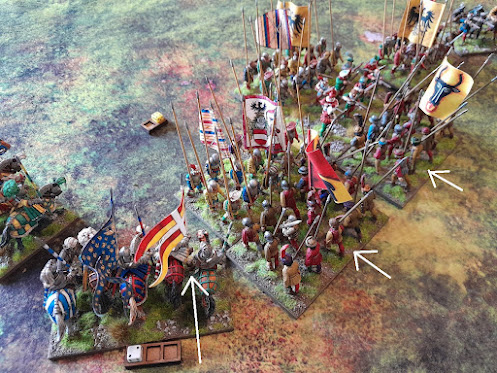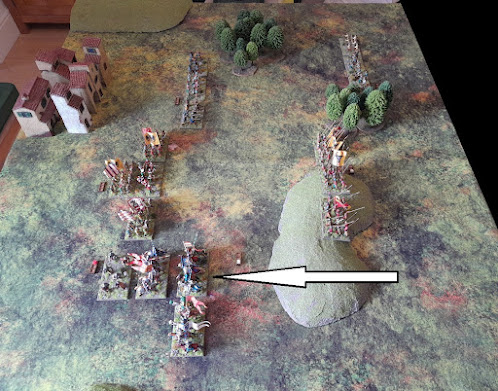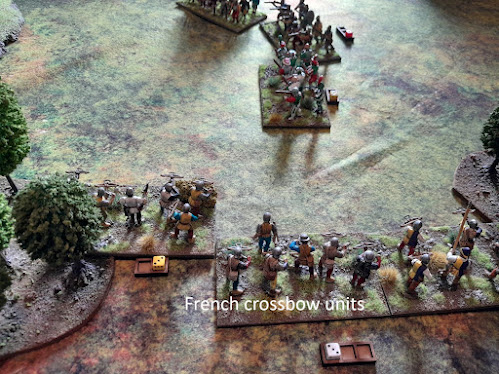Having tested my big game rules for the Italian Wars with success (see here for report), it was time to try out what I hope will be fast play rules for smaller games.
It is hoped that, with these rules, small campaigns can be played by the Rejects with multiple games in a day. Plus, I'm looking to use these rules for quick remote games.
Anyway, let's find out how they played.
 |
| The two armies deployed across the battlefield. In this encounter the nominal sides are Imperial/Spanish versus a French force. |
 |
| The French army deployed in three Battles. Their commander rolled up as an efficient leader. |
 |
| The Imperial forces, also in three Battles. Their leader turned out to be plodding. |
The status of the army commander mostly determines command radius. If a Battle leader is out of command then that Battle may be able to do less in a turn.
Each turn, each army reveals a card which determines the number of actions each unit can carry out (e.g. 1, 2 or 3 actions: move, wheel and shoot). The better the army commander, the more high action cards are available. An Battle out of command always loses an action.
 |
| The Spanish take the opportunity to charge the gendarmes. However, they fail to drive the French back and find themselves embroiled in an ongoing melee. |
 |
| The sword and buckler unit found itself having to withstand a, thankfully, feeble charge from what may be blown horses. |
 |
| Meanwhile, the Swiss and Landsknechts continue to close the distance. In the north, the missile troops of both sides found themselves in a ranged stand-off. |
 |
| With a slight shift of focus, the Imperial arquebusiers poured fire into a French pike block and sent it reeling backwards in alarm. |
 |
On the southern flank, the Spanish men at arms and the sword and buckler units are scattered.
The Imperial flank is looking rather exposed. |
 |
| In the north, the French's weight of shooting causes an Imperial arquebusier unit to rout and disperse. (sorry, the label in the photo is wrong... me bad!) |
 |
| With the centre yet to clash, the Imperial army is having a bad time of it! |
 |
| The French charge the Landsknecht. However, the Swiss Pike is now running on "tired" and can't make the most of their impact. |
Each order adds or takes away from a Battle's exhaustion level. For example, a charge order is +3, manoeuvre is +1, stand and defend is -3. When a Battle reaches 5 it is tired, at 7 it is exhausted. If the Battle gets to -5 it is discouraged, at -7 it is demoralised. Essentially, fatigue leads to minuses to melee and shooting; low morale leads to minuses to unit morale checks.
Afterthoughts
The rules played well. They made for a fun game. Sometimes the Battles did what was being asked of them. However, at some crucial moments they just didn't! To take one instance: with the gendarmes' charge stalled in front of the Spanish men at arms, they had the opportunity to charge. Unfortunately, their order was downgraded to "manoeuvre". They could still move into contact with the gendarmes but did not have the impact to earn the plus 1 in melee.
The rules are an adaptation of an old set bought decades ago. Every time I read them, I find them to my liking. With no desire to start a medieval project, I ran with them and made some changes for the Italian Wars. So far, so good.
So, how long did the game take? and does it meet the quick play criteria of about an hour?
Well, I timed the playing time at1 hour 20 minutes. This included references to the rules during the game. I think that next time it will play faster. Perhaps, I need to limit the number of units to six (there were eight a side in this one) in two Battles a side? I'll ponder on that.
Back to the painting desk, I think.

























That sounds excellent Richard. Some interesting mechanisms. I like he idea that a manoeuvre order might lead to accidental contact. And the tiredness rules sound like something not often seen.
ReplyDeleteChris/Nundanket
Thanks Chris. It's an entertaining feature that stops a player from doing everything they want when they want to.
DeleteYou are getting in a lot of solo gaming of late. That's great and keeps the creativity flowing as you work on two game designs. Is it difficult to work on two different designs with two different scopes simultaneously? While I have a copy of Flowers of Chivalry, I have never really given it much study. Time to pull it from the bookshelf and see exactly where your thoughts originate.
ReplyDeleteThanks Jonathan. I have to acquire the table when I can. Having a mat is proving very handy.
DeleteHaving two designs on the got keeps the engine of my mind at a fairly constant level of revs. But I like that. What makes it slightly easier is that the "big game" rules are largely sourced from my French Wars of Religion rules. A happy consequence is that I believe that I can now improve on them based on my time spent for the Italian Wars... not the same but better.
Have a read Jonathan. It may not be to your taste, but the ideas are interesting.
Great solo game sir!
ReplyDeleteThank you Michal.
DeleteThe use of cards to determine actions sounds interesting, especially the ability to stack the card deck to reflect a commanders capability.
ReplyDeleteThanks Peter. For a Plodding commander, the deck would be 1 action x3; 2 actions x4; 3 actions x2 plus A joker (2 actions) which prompts a reshuffle. Whereas an efficient commander would have 1 acion x2 cards; 2 actions x4; 3 actions x3 plus a joker.
DeleteI like the 'tired' rules mechanic Richard. GDA2 has something similar which they call 'worn' and which affects combat and firing. It forces the player to think carefully about rotating units out of the front line where possible. An hour and twenty minutes makes for a nice quick game.
ReplyDeleteThanks Lawrence. It does make one think. You can recover, or rest, but that means pausing the advance. In a sense, one could justify that as a lull that can often occur in a battle.
DeleteI missed your first test game so really pleased that I saw this one; a gorgeous looking game, with your beautiful figures. Also really interesting to read the descriptions of the action/mechanics of the rules.
ReplyDeleteAs the others have noted, the accumulation and recovering of fatigue/demoralisation is a really good mechanic. I first saw it in the Empire rules (I came in at v3). Far earlier Zimmermann had a similar thing for variable morale, where each unit has a starting level and it decreases or increases with losses/victories/losing or capturing trophies. If it gets to zero, the unit retreats.
Looking forward to more of your games with these lovely figs,
James
Your comments are welcome and encouraging James. Glad you liked the mechanics described. Just goes to show that there really isn't anything new; just adaptations.
DeleteA great looking game and an enjoyable read, the rules seem to give a very good, quick game.
ReplyDeleteThank you Donnie. Appreciate your comments. So far, so good!
DeleteFine looking game and admirable to try and achieve something that can be played in an hours or so. I find that by sticking with core rules that use very similar game mechanics, I can get in decent sized games played to a conclusion in less than two hours. Probably much less if I wasn't taking notes and photos for an AAR!
ReplyDeleteThanks Steve. The rules a simple and quite quickly learned. My enjoyment is as much about the intellectual/creative process. I kind of like different rules for different periods. Otherwise, I could make life easy and use Pike and Shotte/Blackpowder for everything.
DeleteGreat looking game again, Richard. I like the idea of fastplay too. I plan to do my initial Italian Wars gaming with the Battle of Bicocca - using the scenario pretty much out of the Warlord Games supplement.
ReplyDeleteThank you Dean. I look forward to your game report. What rules will you use?
DeleteGreat sounding and looking game, I wouldn't reduce the army size, I think it sounds like once you'd played it a few times it would speed up with these sized armies? Interesting as I'm considering trying to do a campaign in a day for the Italian Wars and was planning on a simplified warlord pike and shot?
ReplyDeleteBest Iain
Thanks Iain. Your campaign sounds interesting. I look forward to seeing how you run it.
DeleteLooks a great game Rich. Can't wait to have a go myself. I'm surexwe used to play those rules years ago. I definitely used the FIW version, by the same authors. I thought I commented on this post already? Check your spam?
ReplyDeleteThanks Ray. We did once, decades ago.
DeleteChecked spam, you hadn't commented.